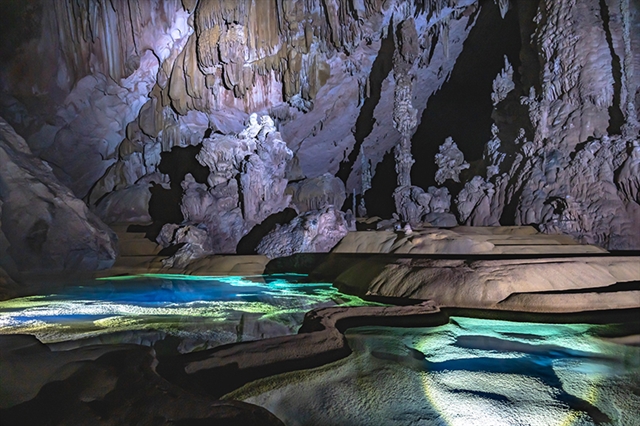Aside from existing tourism routes and sites, the development project outlines 20 new service areas in need of investment, including nine new spots and 11 routes with potential.

Cave exploration tours always attract tourists to Phong Nha-Kẻ Bàng National Park. Photo bvhttdl.gov.vn
QUẢNG BÌNH — The central province of Quảng Bình's Phong Nha-Kẻ Bàng National Park Management Board has announced a project to boost tourism in the area calling for investment in nine destinations and 11 tourist routes by 2030.
The project, themed 'Eco-tourism, Resort and Entertainment in Phong Nha-Kẻ Bàng National Park', is expected to cost VNĐ1,253 billion (US$49.2 million).
It aims to develop the park's main tourism area, which covers 124,832 hectares including the entire national park and part of the adjacent protected forest, which has been assigned to the board for management and protection until 2030.

Part of Tiên Sơn Cave in Phong Nha-Kẻ Bàng National Park in Quảng Bình Province. VNA/VNS Photo
The project proposal was released along with a plan to enhance and promote investment in tourism development in 2024 at a conference held this past weekend by the provincial People's Committee and the park's management board.
Aside from existing tourism routes and sites, the project outlines 20 new service areas in need of investment, including nine new spots and 11 routes with potential.
The new tourism routes will help visitors explore forests, caves and rivers within the park, as well as historical sites along the Hồ Chì Minh Highway in Bố Trạch District.

The Phong Nha-Kẻ Bàng National Park welcomes tourists on the first day of this year. The park is aiming to welcome 1.5 million visitors through 2025. VNA/VNS Photo
New tourist spots include the Tourism Management and Operations Centre; an eco-tourism spot in the zoo along with a visit to a wildlife rescue area; a high-quality resort at 20 Quyết Thắng Street; the Núi Đôi wildlife breeding and rescue area; a high-class resort in the U Bò U mountain area; eco-tourism sites at Chày Waterfall and Stream 40; and the Bà Tây Hill and Trắm Ná resort areas.
Meanwhile, the 11 new routes with unique potential will focus on tours exploring Re Forest to the Máy Bay ravine; the Cà Roòng and Kling Acuc caves; Vòm Cave to Voọc Well; the caves of Chỉ Huy, Cây Sanh and Bài; the U Bo peak; a spruce forest; Hòa Hương Cave; Khe Ry Cave; the culture and history of Công-Nông-Binh Cave; the western part along the Hồ Chí Minh Highway, inter-province road 562; and the Hung Lau area.
Speaking at the conference, Vice Chairman of the Quảng Bình Provincial People's Committee Hoàng Xuân Tân emphasised the importance of the project, saying it has affirmed the province's "determination, vision and target orientation" to further improve the management, conservation and sustainable development of Phong Nha-Kẻ Bàng National Park and its value as a world natural heritage site.
He asked that the Phong Nha-Kẻ Bàng National Park Management Board urgently set up a specific detailed plan for the project's implementation.
The board should update, evaluate and detect inadequacies and potential problems to promptly coordinate with relevant authorities to create the best conditions for investors, according to the provincial authority official.
He also assigned the province's Department of Planning and Investment to coordinate with the board to select priority investment items and add them into the province's investment promotion list to call for investments from both domestic and global businesses.
Relevant departments and local authorities should also closely coordinate with the park's management board in implementing the project and continue to promote the region's heritage, he said.
According to a representative from Phong Nha-Kẻ Bàng National Park, the park has become an attractive destination for both domestic and foreign tourists since it was recognised by UNESCO more than 20 years ago.
However, its tourism offerings are not commensurate with its potential, and the quality of some services remains low.
National park director Phạm Hồng Thái said he wanted enterprises to invest in new tourism routes and areas to offer visitors the best experience of the world heritage site’s unique landscapes.
The Phong Nha-Kẻ Bàng National Park is aiming to welcome 1.5 million visitors through 2025, with expected revenues of VNĐ500 billion, and three million visitors in 2030, with expected revenues of VNĐ1,500 billion.
The Quảng Bình Province development master plan has highlighted Phong Nha-Kẻ Bàng national tourist area as a high-quality tourism centre in Southeast Asia.
The plan also identifies it as one of the province's two main "growth driving centres" in the period 2021-2030.
Phong Nha-Kẻ Bàng National Park was twice recognised as a World Natural Heritage site by UNESCO.
In 2003, UNESCO recognised Phong Nha-Kẻ Bàng National Park according to geological and geomorphological criteria and in 2015, the park was again honoured as a World Natural Heritage site for the second time, based on biodiversity criteria. VNS